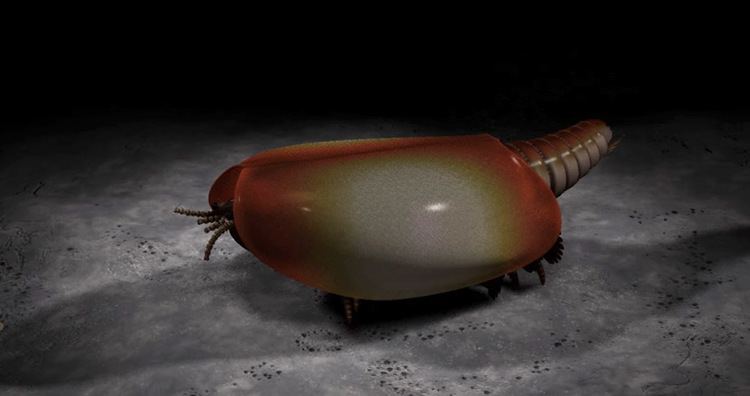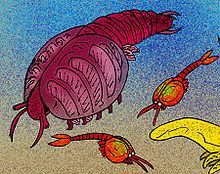Order †Canadaspidida Rank Species | Family †Canadaspididae | |
 | ||
Genus †CanadaspisBriggs, 1978 Similar Odaraia, Waptia, Perspicaris, Sidneyia, Leanchoilia | ||
Canadaspis ("Shield of Canada") was a Cambrian genus of crustacean or euarthropod, a benthic feeder that moved mainly by walking and possibly used its biramous appendages to stir mud in search of food. The genus has been placed within the subclass Phyllocarida, in the class Malacostraca that includes shrimps and lobsters.
Contents

The organism

Canadaspis had claws on the end of its frontal appendages which may have been used to stir up sediment, or to scrape off the top layer, which may have been a nutritious layer of microbes. Large particles it stirred up would have been captured by spines on the inside of its legs; these spines would have directed the food particles to the organism's mouth, where it used its mandibles to grind larger particles.

Its antennae served a sensory function. Spines on its head probably served to protect its vulnerable eyes from predators. Its limbs probably moved in sequence to produce a rippling motion. Although Canadaspis probably did not swim, this could have helped propel the organism from under soft sediments. The appendages also produced currents which would have helped with feeding and respiration.
Canadaspis is very closely related to the similar organism Perspicaris, differing only in morphological detail.
Classification of Canadaspis

Three alternatives exist for Canadaspis's classification. They concern its relationship to the crustacea; it was originally thought that it falls within that clade, but this no longer appears to be the case. The alternatives are that it is a stem group crustacean, but others believe it is more basal still, falling in the base of the euarthropoda.
Fossil occurrences

4525 specimens of Canadaspis are known from the Greater Phyllopod bed, where they comprise 8.6% of the community. Canadapsis perfecta, the type species, comes from the Cambrian-age Burgess Shale in British Columbia, Canada. Canadaspis are also found in different formations of the House Range of western Utah as well as the Pioche Shale of Nevada. Canadaspis laevigata, coming from the Chengjiang biota and thus some 10 million years older than Canadapsis perfecta, is an equivocal member of the genus. Some scientists believe Canadaspis laevigata to be a more primitive Crustaceomorpha antecedent of Canadaspis, and others consider it a bi-valved arthropod of uncertain affinity.
